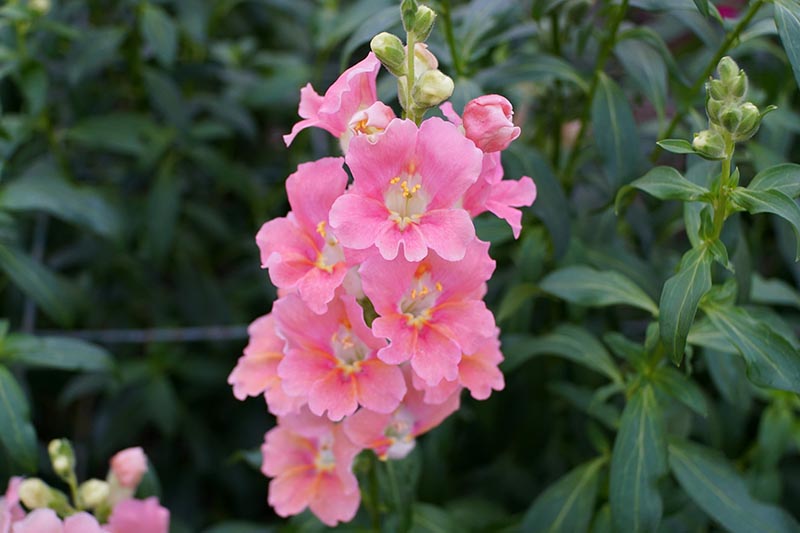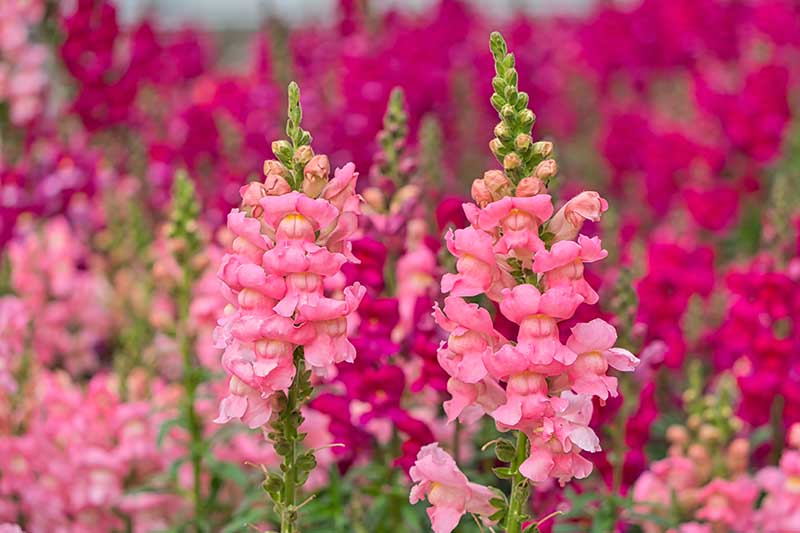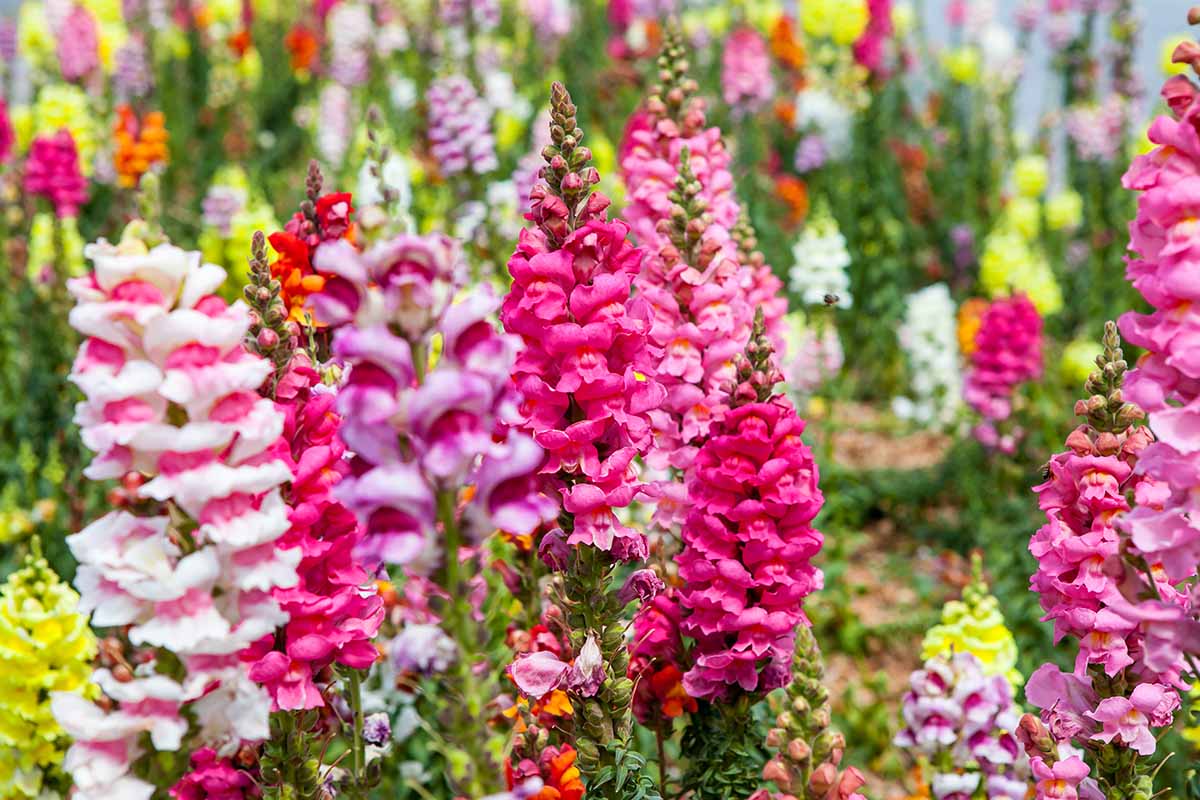We link to vendors to help you find relevant products. If you buy from one of our links, we may earn a commission. Don’t worry, we’ve got your back. This guide will make everything a bit more clear so you’ll be able to march confidently into the store and request their prettiest Group IV, double-flowered, multicolored series on offer. Ready to start your snapdragon education? Here’s what you can expect, coming up in this guide: Before you wade into the weeds, you might want to familiarize yourself with our snapdragon growing guide. Prep your vases and start dreaming about your perfect cottage garden, because we’re about to jump in.
Flower Type
There are two types of snapdragon flowers. The first is the familiar single-flower type, with the hinged jaw that opens like a mouth. The second type is the double flower, also known as a butterfly or azalea snapdragon. Double snapdragon flowers look a bit like azaleas, with more abundant, flatter petals. Some people say they resemble butterflies, hence the other common name. The double-flower types stay in bloom longer than single-flower types. Flowers in the Aroma series are classic examples of single-flower types while Bright Butterflies is a popular double-flower series.
Group Classification
These flowers are often classified according to their ideal growing season and the flowering period based on the temperature and number of available daylight hours. This isn’t an official botanical system, but more of a way to separate the available plants according to the time of year during which they really shine, for commercial growers as well as home gardeners.
Group I: Winter
Snapdragons in this group do well in the weaker light and during the shorter days of winter in Zone 7, or Zone 6 with some protection. They are shorter and have small flower heads, but they develop and start flowering quickly, early in the season. These can be grown in tunnels or under frost cloth when they’re young, and they also do well in greenhouses. Flowers in the Admiral, Chantilly, and Alaska series are all Group I types.
Group II: Early Spring
Plants in this group need brighter light and longer days than winter types, but less than summer types. They tend to be medium in height with medium-sized flowers. You can start these in tunnels or under frost cloth early in the year. Group II series and cultivars include Cinderella, Costa, and ‘Little Darling.’
Group III: Late Fall
This group is similar to early spring types and there can be some overlap. They grow best during the fall and tend to bloom later in the growing season. Group III includes Animation and Apollo series plants.
Group IV: Summer
Plants in this Group need the most light and the longest days of all the cultivars. They’re tall and need a long time to mature, and bloom later in the year. Don’t try to extend your growing season by using tunnels or frost cloth. These block the kind of bright, intense summer light that these types thrive in. If you don’t have a long enough growing season for a summer type, grow one of the other options instead. Group IV includes Rocket and Opus series flowers. Filling your garden with Antirrhinum types from different groups will provide an ongoing show of color from one season to the next, provided you have the right growing conditions available.
Height and Growth Habit
Snapdragons are also sometimes grouped according to their mature height. You’ll see the following groupings in plant descriptions:
Tall – 24 to 36 inchesIntermediate – 12 to 24 inchesShort – 9 to 12 inchesDwarf – 4 to 9 inches
For the tall types, it can help to provide cages or supports if you want to harvest the stalks for cut-flower displays. The Admiral, Chantilly, and Liberty series are all tall types. Dwarf varieties are excellent for use in containers, and you will also sometimes see these referred to as miniatures. Popular series include Tahiti, Bells, Floral Showers, and Montego. While most types have an erect, upright growth habit, trailing types are also available. These include Chandelier, Lampion, and Luminaire series plants.
Series and Cultivars
Many cultivars are trademarked and sold in what are called “series,” which in the case of this type of plant are groups of identical flowers that vary only in color. Otherwise, they reach the same height and have the same growing requirements. Don’t confuse the term series with the botanical designation, which is a subdivision of a genus. It’s usually just a name that the breeder or seller gives a group of snapdragons with similar characteristics and varying colors. A broad selection of series are available, and the list continues to grow. Some popular series that you may have heard of include those already mentioned above, as well as Floral Carpet, Princess, Double Azalea, Opus, and Chimes. “Series” is also a term used in botanical classification, to denote a genus subdivision that’s below section and above species. But in this case, it’s purely a term used in marketing. You’ll also see heirloom and hybrid cultivars that are not part of a series. ‘Black Prince’ is a popular heirloom cultivar with deep purple flowers and dark green foliage. For more details about our favorite series and cultivars and information on where to buy them, read our roundup of the best snapdragon series and cultivars to grow at home. But there are so many variations, whether you want something weeping and multicolored, or nearly black and extremely upright. What kind are you going to choose? Let us know in the comments section below! I hope this guide helped you to make sense of the wonderful world of snapdragons. If so, you might be interested in some of our other guides next:
How to Grow Snapdragons in ContainersEating Snapdragons: How to Harvest and Use the Flowers and LeavesAre Snapdragons Annuals or Perennials? The Lowdown on How Long Snapdragons Live




